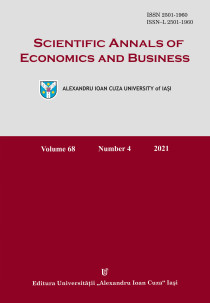Determining the Return Volatility of Major Stock Markets Before and During the COVID-19 Pandemic by Applying the EGARCH Model
Determining the Return Volatility of Major Stock Markets Before and During the COVID-19 Pandemic by Applying the EGARCH Model
Author(s): Letife Özdemir, Ercan Özen, Simon Grima, Inna RomanovaSubject(s): Economy, Financial Markets
Published by: Editura Universităţii »Alexandru Ioan Cuza« din Iaşi
Keywords: Corona Virus (COVID-19); pandemics; return volatility; stock indexes; EGARCH;
Summary/Abstract: With this study, we aim to determine the effect of the Covid-19 pandemic on the return volatility of the DJI, the DAX, the FTSE100 and the CAC40 stock indexes. We take return volatility between 1st January 2019 and 17th July 2020 and split it into two separate periods - before the Covid-19 pandemic outbreak and the first wave of the ‘In-Pandemic’ period. Only the so-called first wave of the pandemic was chosen to avoid the influence of knowledge of possible vaccines and antiviral solutions. Data were analysed by using the exponential GARCH (EGARCH) model. Findings show excessive volatility in the major stock markets with short volatility persistence and the presence of leverage in returns during the first wave of the Covid-19 pandemic outbreak. Moreover, during the pandemic period, positive shocks have been observed to have a greater effect than negative socks on the stock index return volatility.With this study, we aim to determine the effect of the Covid-19 pandemic on the return volatility of the DJI, the DAX, the FTSE100 and the CAC40 stock indexes. We take return volatility between 1st January 2019 and 17th July 2020 and split it into two separate periods - before the Covid-19 pandemic outbreak and the first wave of the ‘In-Pandemic’ period. Only the so-called first wave of the pandemic was chosen to avoid the influence of knowledge of possible vaccines and antiviral solutions. Data were analysed by using the exponential GARCH (EGARCH) model. Findings show excessive volatility in the major stock markets with short volatility persistence and the presence of leverage in returns during the first wave of the Covid-19 pandemic outbreak. Moreover, during the pandemic period, positive shocks have been observed to have a greater effect than negative socks on the stock index return volatility.With this study, we aim to determine the effect of the Covid-19 pandemic on the return volatility of the DJI, the DAX, the FTSE100 and the CAC40 stock indexes. We take return volatility between 1st January 2019 and 17th July 2020 and split it into two separate periods - before the Covid-19 pandemic outbreak and the first wave of the ‘In-Pandemic’ period. Only the so-called first wave of the pandemic was chosen to avoid the influence of knowledge of possible vaccines and antiviral solutions. Data were analysed by using the exponential GARCH (EGARCH) model. Findings show excessive volatility in the major stock markets with short volatility persistence and the presence of leverage in returns during the first wave of the Covid-19 pandemic outbreak. Moreover, during the pandemic period, positive shocks have been observed to have a greater effect than negative socks on the stock index return volatility.
Journal: Scientific Annals of Economics and Business
- Issue Year: 68/2021
- Issue No: 4
- Page Range: 405-419
- Page Count: 15
- Language: English

